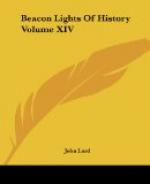We pass to a consideration of Darwin’s masterworks, the “Origin of Species,” the “Variation of Animals and Plants under Domestication,” and the “Descent of Man.” Before indicating the conclusions reached in the first of these works, we should point out to what extent Darwin had been preceded by dissenters from the belief once almost universally entertained by biologists that species were independently created, and, once created, were immutable. Lamarck was the first naturalist whose divergent views upon the subject excited much attention. In writings published at various dates from 1801 to 1815, he upheld the doctrine that all species, including man, are descended from other species. He pronounced it probable that all changes in the organic, as well as in the inorganic world, were the result of law, and not of miraculous interposition. He seems to have been led to his opinion that the change of species had been gradual by the difficulty experienced in distinguishing species from varieties by the almost perfect gradation of forms in certain groups, and by the analogy of domestic productions. With respect to the means of modification, he attributed something to the direct action of the physical conditions of life, something to the crossing of already existing forms, and much to use and disuse, or, in other words, to the effect of habit. Finally, he held that characters acquired by an existing individual might be transmitted to its offspring.
In 1813 Dr. W.C. Wells read before the Royal Society “An Account of a White Female, Part of whose Skin resembles that of a Negro.” In this paper the author distinctly recognized the principle of natural selection, but applied it only to the races of man, and in man only to certain characters. After remarking that negroes and mulattoes enjoy an immunity from certain tropical diseases, he observed, first, that all animals tend to vary in some degree, and, secondly, that agriculturalists improve their domesticated animals by selection. He added that what is done in the latter case by art seems to be done with equal efficacy, though more slowly, by nature in the formation of varieties of mankind fitted for the countries which they inhabit. Again in 1831 Mr. Patrick Matthew published a work on “Naval Timber and Arboriculture,” in which he put forth precisely the same view concerning the origin of species as that propounded by Mr. Wallace and by Darwin. Unfortunately for himself, the view was cursorily suggested in scattered passages of an appendix to a work on a different subject, so that it remained unnoticed until Mr. Matthew himself drew attention to it in 1860, after the publication of the “Origin of Species.” We observe finally that Mr. Herbert Spencer, in an essay published in 1852, and republished six years later, contrasted the theories of the creation and the development of organic beings. He argued from the analogy of domestic productions, from the changes which the embryos of many species undergo, from the difficulty of distinguishing species and varieties, and from the principle of general gradation, that species have been modified; and he attributed the modification to the change of circumstances.




